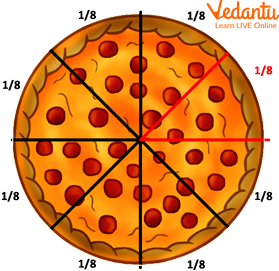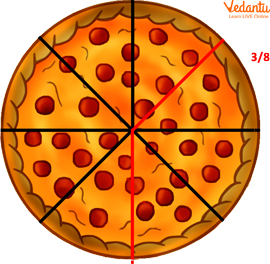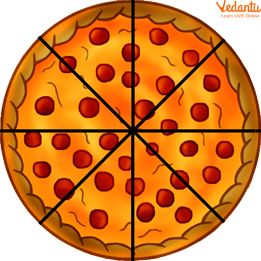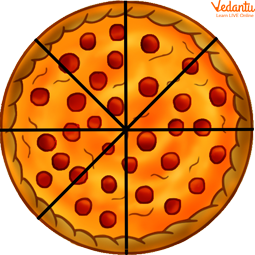




Types of Fractions - Examples | 3 Types of Fractions
In mathematics, fractions are categorised into three main types: proper fractions, improper fractions, and mixed fractions. A fraction is a term that consists of a numerator and a denominator, and its type is determined based on these two parts.
Fractions represent parts of a whole object. For example, if a pizza is cut into four equal slices, each slice is represented as 1/4 of the pizza. Here, the number 1 is the numerator, and 4 is the denominator.
In addition to the three main types of fractions, there are three more categories: like fractions, unlike fractions, and equivalent fractions. Therefore, there are a total of six types of fractions: proper fractions, improper fractions, mixed fractions, like fractions, unlike fractions, and equivalent fractions.
What is a Fraction?
A fraction is a portion of a whole object. The fraction indicates how many parts you have of anything when it is divided into several pieces. It is expressed as the number of equal parts counted (the numerator) divided by the total number of parts (the denominator).

Fraction
Types of Fractions with Examples
In Maths, there are three Different Types of Fractions They are
Proper Fractions,
Improper Fractions
Mixed Fractions.
1. Proper Fraction
A proper fraction is one in which the numerator (number of equal parts counted) is less than the denominator (total number of parts). These fractions are all less than on the number line.

Proper Fraction
The above pizza example, with each person receiving ⅜ th of the pizza, demonstrates a proper fraction.
2. Improper Fraction
An improper fraction occurs when the numerator (number of equal parts counted) is greater than the denominator (total number of parts). These fractions are greater than one and lie on the number line beyond one. When more than one thing is divided into equal halves, they come into play. The number of equal parts is represented by the denominator. The numerator represents the number of available parts.
For example, there are a total of 8 slices in each. One has 8 slices left, and the other has only 6 slices. So, the fraction representing;

Improper Fraction

Improper Fraction with 6 Parts
Addition of both pizza’s parts and whole =
3. Mixed Fraction
As the name suggests, it combines a whole and a 'part.' By dividing the numerator by the denominator and obtaining the quotient and remainder, an improper fraction can be stated as a mixed fraction.
For example:
4. Unlike Fractions
Fractions with different denominators are called unlike fractions. Here the denominators of fractions have different values.
So, it can also be defined as fractions having the same numerator and different denominators are known as unlike fractions.
For example:
5. Like Fractions
Fractions with same denominator and different numerators are known as like fractions.
For example:
6. Unit Fractions or Unique Fractions
Fractions that have 1 as a numerator are known as unit fractions or unique fractions.
For Examples:
7. Equivalent Fractions
Equivalent fractions are fractions that have the same value when simplified.
For example:
Summary
This article discusses that a fraction is a portion of a complete part of the object. The fraction shows how many parts you have of anything when divided into several pieces. It is expressed as the number of equal parts counted (numerator) divided by the total number of parts (denominator). There are 7 kinds of fractions; Proper Fractions, Improper Fractions, Mixed Fractions, Like Fractions, Unit Fractions, Equivalent Fractions and Same Numerator Fractions. If you enjoyed reading this and want to learn more about fractions, visit our website.
FAQs on Types of Fraction
1. What are the major types of fractions in mathematics?
In mathematics, we have three major types of fractions and those are proper fractions, improper fractions, and mixed fractions. But we have three more types of fractions and those are like fractions, unlike fraction and equivalent fraction. In total, there are mainly 6 types of fractions.
2. Are the fractions
By comparing the numerators of the fraction, we can compare two fractions with like denominators. The fraction with the larger numerator is the greater fraction since it contains more part of the total object. The fraction that has a smaller numerator is the smaller fraction since it includes a smaller part of the whole object. Therefore, if two fractions have the same denominator, then equivalent fractions have equal numerators.
In simplest form;
Since the simplest form of both the fractions is
3. What is a denominator in fractions?
The denominator in a fraction is the bottom part of a fraction. In Mathematics, a denominator is a number in a fraction that indicates a whole is divided into how many equal parts.
4. What is the difference between proper and improper fractions?
Proper fractions: The numerator is smaller than the denominator (e.g., 3/5).
Improper fractions: The numerator is larger than or equal to the denominator (e.g., 7/4).
5. What is a mixed fraction?
A mixed fraction consists of a whole number and a proper fraction combined, such as 2 1/3.
6. What is like and unlike fractions?
Like fractions: Fractions with the same denominator (e.g., 2/7 and 5/7).
Unlike fractions: Fractions with different denominators (e.g., 2/5 and 3/8).
7. How do you simplify a fraction?
To simplify a fraction, divide the numerator and denominator by their greatest common divisor (GCD). For example, 24/36 can be simplified to 2/3 by dividing both by 12.
8. How can you tell if two fractions are equivalent?
Two fractions are equivalent if their cross-products are equal. For example, for 3/4 and 6/8:
9. What are equivalent fractions?
Equivalent fractions are fractions that represent the same part of a whole, even though their numerators and denominators are different. For example, 1/2, 2/4, and 4/8 are equivalent fractions.
10. How do fractions help in time management?
Fractions are used to divide time into smaller units, such as hours, minutes, and seconds. For instance, 1/4 of an hour is 15 minutes.
11. What is the importance of fractions in measurements?
Fractions are widely used in measurements for construction, sewing, and engineering to ensure precision. For example, measurements like 3/8 inch or 5 1/2 feet are common.
12. Can improper fractions be converted to mixed numbers?
Yes, improper fractions can be converted to mixed numbers by dividing the numerator by the denominator. The quotient is the whole number, and the remainder is the numerator of the fraction.
13. How Many Types of Fractions?
There are six types of fractions: proper fractions, improper fractions, mixed fractions, like fractions, unlike fractions, and equivalent fractions. Each type helps describe parts of a whole in different forms, such as equal denominators, mixed numbers, or equivalent values.



































